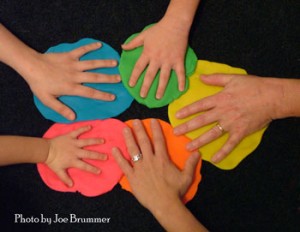
This week’s guest blog is from Jill:
Sometimes we think fighting is just “what kids (or adults) do,” rather than a way we engage when our needs aren’t getting met. I prefer to think of engaging peacefully as “what we do,” and that when we get off track, we can use a hand to get back to a place of connection.
I remember when my son was about three, his dad was in a bread-making phase. Sometimes I liked the results, and sometimes I didn’t. While at the local farmer’s market, my son and I found a particularly yummy loaf of walnut bread, and brought it home discreetly. When his dad saw it, he became incredulous.
“Bread??? You BOUGHT bread!?!?!?”
Canaan felt the tension here. I’ll never forget his response. He raised his body up, opened his arms to the two of us, and proclaimed,
“We all eat bread! There’s farmer’s market bread, and Da-da’s bread, and all kinds of bread to eat.”
Well, shall we let a thousand flowers bloom, or what?
I see this as his attempt to introduce a larger perspective, or “third side,” to his dad’s and my moment of polarization. Sometimes all this takes is showing up with a loving, aware presence.
I remember my stepmother discovering the term “triangualation” in the 80’s, and telling me it was “toxic.” She was referring to one person getting into, or in between two other people who were having a difficult time, creating a “triangle” of three people. Unfortunately, this was the only term in our universe at that time to describe a third person entering into an interaction with two others. There was no positive way to describe a third side to an entanglement.
Today, as a mediator and lifetime student of conflict resolution, I see many ways a third person can show up in a family and help to ease tensions for the other two or more people who are having a hard time to make things easier. This is something humans do intuitively, even when the results aren’t optimal. Kids do it, too, as my son demonstrated above.
Below I’ll outline some “business as usual” ways of intervening—examples from my own childhood, and what I still see around me—that don’t meet my needs for connection and respect. Then I’ll suggest some alternatives that do meet my needs for connection and respect.
Business-as-usual interventions
1 – Demand that the interaction stop. My sister and I used to get that a lot. “Would you kids just stop fighting!?”
2 – Interpret the scenario, and explain who deserves what. “You grabbed the toy from her, so now you can wait until she finishes pummeling it.”
3 – Take over the interaction. “Okay, give me the toy, you obviously can’t share it peacefully. You can have it back in ten minutes.”
I can see any of these interventions as strategies for adults to find peace in the family. I’ve used some versions of these myself.
However, in the long run, since none of these relates to what’s going on inside the participants, or involves them in the decision-making process, I see them as merely directing traffic rather than connecting or empowering. Sometimes we do that just to get by. If we can supplant a significant part of our traffic direction with family mediation that connects and empowers, we can help to build trust and skills within our family so that the next time, the young ones (or the adults) may have more tools in their toolbox to work out the conflict themselves.
Here are some ways to intervene that do meet my needs for connection and respect:
1 – Say what you’re hearing said, and ask the other party to reflect it back. “I just heard Malika say she didn’t want to play that game any more—could you tell me what you heard her say?” Then give the other side equal time, and help the first person hear them, too.
2 – Say what you’re seeing or hearing, how you feel, what you need, and what you’d like. “When I hear the sound of your voices right now, I feel anxious. I need peace. Would you be willing to play in the other room, or at least keep your voices down if you want to stay in here? (In fairness, this is a lot harder than it sounds.)
3 – Guess at what each person is feeling. “Chong, it looks like you’re feeling sad. Are you wanting to play with Paulina and Sandip?” “Paulina, were you enjoying what you were doing, and having a hard time figuring out how to include Chong?”
4 – Ask for cooperation in a peaceful solution. “Joseph, would you be willing to let Sasha know when you’re done with the Wii? Sasha, would you like to help me with making the cookies until then?”
If you can do part of the above, you may be able to use your position as the “third side” of the conflict to change the tone of an interaction from antagonistic to respectful. And, like contention, even a little peace in a family can go a long way.
Please let us know how it works out!
And have a great week, Jill
Jill Nagle is the cofounder of Awakeparent.com, and former regular blogger. Currently, she blogs at Zendesk.com, works as a freelance writer and content strategist, and does family mediation with a focus on creative family structures. She works over the phone as well as in person. Learn more here: http://tinyurl.com/thirdsidemediation

